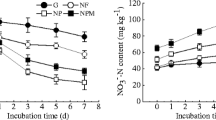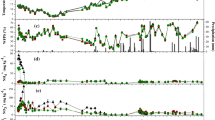Abstract
The responses of δ15N–N2O isotopic signatures to nitrogen (N) fertilization in in situ soils are not yet clear in agricultural field settings. We therefore conducted a 1-year field experiment to assess how N fertilization (0 and 400 kg N ha−1 year−1, N0 and N400) affects the δ15N–N2O isotopic signatures both at soil surface and in soil profile (0–3 m) in a wheat–maize rotation in North China. N fertilization increased N2O concentrations by 18–79% in the soil profile. It increased N2O fluxes by 9 times and 1–7 times at the soil surface and 0–0.9 m soil depth, respectively. In comparison, N fertilization reduced δ15N–N2O values by 10–74% in the soil profile. It reduced δ15N–N2O isotopic signatures at the soil surface and in the soil profile by 18% and 33%, respectively. The δ15N–N2O isotopic signature was dominated by substrate δ15N signature and N isotope fractionation during cold and warm seasons, respectively. Our results indicate that denitrification steps of NO3− → N2O dominated N2O production (over 99%) in the N0 treatment and the N400 treatment during N-fertilizer-free period. Following N fertilization, the NO3− → N2O dominated N2O production (over 99%) in the soil profile, N2O flux from the soil surface was mostly derived from NO3− → N2O and less from NH4+ → N2O. Overall, denitrification was found to dominate soil N2O transformation metabolism in the wheat–maize rotation cropland in North China.
Graphic abstract






Similar content being viewed by others
References
Barford CC, Montoya JP, Altabet MA, Mitchell R (1999) Steady state nitrogen isotope effect of N2 and N2O production in Paracoccus denitrificans. Appl Environ Microbiol 65(3):989–994
Barrat HA, Evans J, Chadwick DR, Clark IM, Cocq KL, Cardenas LM (2020) The impact of drought and rewetting on N2O emissions from soil in temperate and Mediterranean climates. Eur J Soil Sci. https://doi.org/10.1111/ejss.13015
Bateman AS, Kelly SD (2007) Fertilizer nitrogen isotope signatures. Isotopes Environ Health Stud 43:237–247
Birch HF (1964) Mineralization of plant nitrogen following alternate wet and dry conditions. Plant Soil 20:43–49
Bourbonnais A, Letscher RT, Bange HW, Échevin V, Larkum J, Mohn J, Yoshida N, Altabet MA (2017) N2O production and consumption from stable isotopic and concentration data in the Peruvian coastal upwelling system, Global Biogeochem. Cycles 31:678–698
Bouyoucos GJ (1936) Directions for making mechanical analysis of soils by the hydrometer method. Soil Sci 42(3):225–228
Brasher BR, Franzmeier DP, Valassis VT, Davidson SE (1966) Use of saran resin to coat natural soil clods for bulk density and water-retention measurements. Soil Sci 101:108
Casciotti KL, Sigman DM, Hastings MG, Bohlke JK, Hilkert A (2002) Measurement of the oxygen isotopic composition of nitrate in seawater and freshwater using the denitrifier method. Anal Chem 74:4905–4912
Casciotti KL, Sigman DM, Ward BB (2003) Linking diversity and stable isotope fractionation in ammonia-oxidizing bacteria. Geomicrobiol J 20:335–353
Castellano-Hinojosa A, Charteris AF, Christoph Müller C, Jansen-Willems A, González-López J, Bedmar EJ, Carrillo P, Cárdenas LM (2020) Occurrence and 15N-quantification of simultaneous nitrification and denitrification in N-fertilised soils incubated under oxygen-limiting conditions. Soil Biol Biochem 143:107757
Castellano-Hinojosa A, González-López J, Bedmar EJ (2018) Distinct effect of nitrogen fertilisation and soil depth on nitrous oxide emissions and nitrifiers and denitrifiers abundance. Biol Fertil Soils 54:829–840
Coplen TB (2011) Guidelines and recommended terms for expression of stableisotope- ratio and gas-ratio measurement results. Rapid Commun Mass Spectrom 25:2538–2560
Denk TRA, Mohn J, Decock C, Lewicka-Szczebak D, Harris E, Butterbach-Bahl K, Kiese R, Wolf B (2017) The nitrogen cycle: A review of isotope effects and isotope modeling approaches. Soil Biol Biochem 105:121–137
FAO-WRB (SSS-ISRIC-FAO-UNESCO) (1998) World reference base for soil resources, World Soil Resources Report No. 84. FAO, Rome
Guo XB, Drury CF, Yang XM, Reynolds WD, Fan RQ (2014) The extent of soil drying and rewetting affects nitrous oxide emissions, denitrification, and nitrogen mineralization. Soil Sci Soc Am J 78:194–204
Hu HW, Chen D, He JZ (2015) Microbial regulation of terrestrial nitrous oxide formation: understanding the biological pathways for prediction of emission rates. FEMS Microbiol Rev 39:729–749
Hutchinson GL, Livingston GP (1993) Use of chamber systems to measure trace gas fluxes. In: Harper LA, Moiser AR, Duxbury JM, Rolston DE (eds) Agro-ecosytem effecton radiatively important trace gases and climate change, vol 55. American Society of Agronomy, Madison, pp 63–78
Kevin W, Mandernack I, Thomas R (2000) The biogeochemicaclo ntrolso f the δ15N and δ18O of N2O produced in landfill cover soils. J Geophys Res 105(14):17709–17702
Lewicka-Szczebak D, Well R, Bol R, Gregory AS, Matthews GP, Misselbrook T, Whalley WR, Cardenas LM (2015) Isotope fractionation factors controlling isotopocule signatures of soil-emitted N2O produced by denitrification processes of various rates. Rapid Commun Mass Spectrom 29:269–282
Lewicka-Szczebak D, Well R, Koester JR, Fuss R, Senbayram M, Dittert K, Flessa H (2014) Experimental determinations of isotopic fractionation factors associated with N2O production and reduction during denitrification in soils. Geochim Cosmochim Acta 134:55–73
Makabe A, Koba K, Toyoda S, Yoshida N (2007) Isotopomeric signature of nitrous oxide discharged from Lake Biwa in Japan and a polluted river in Mongolia. American Geophysical Union, Fall Meeting. abstract id: B41G-03
Mandernack KW, Mills CT, Johnson CA, Rahn T, Kinney C (2009) The δ15N and δ18O values of N2O produced during the co-oxidation of ammonia by methanotrophic bacteria. Chem Geol 267:96–107
Martínez-Espinosa C, Sauvage S, Bitar AA, Green PA, Vörösmarty CJ, Sánchez-Pérez JM (2021) Denitrification in wetlands: a review towards a quantification at global scale. Sci Total Environ 754:142398
Menyailo OV, Hungate BA, Lehmann J, Gebauer G, Zech W (2003) Tree species of the central amazon and soil moisture alter stable isotope composition of nitrogen and oxygen in nitrous oxide evolved from soil. Isot Environ Health Stud 39(1):41–52
Mohn J, Tuzson B, Manninen A, Yoshida N, Toyoda S, Brand WA, Emmenegger L (2012) Site selective real-time measurements of atmospheric N2O isotopomers by laser spectroscopy. Atmos Meas Tech 5:1601–1609
Nikolenko O, Jurado A, Borges AV, Knöller K, Brouyère S (2018) Isotopic composition of nitrogen species in groundwater under agricultural areas: a review. Sci Total Environ 621:1415–1432
Opdyke MR, Ostrom NE, Ostrom PH (2009) Evidence for the predominance of denitrification as a source of N2O in temperate agricultural soils based on isotopologue measurements. Glob Biogeochemi Cycles 23(4):GB4018. https://doi.org/10.1029/2009GB003523
Ostrom NE, Pitt A, Sutka R, Ostrom PH, Grandy AS, Huizinga KM, Robertson GP (2007) Isotopologue effects during N2O reduction in soils and in pure cultures of denitrifiers. J Geophys Res Biogeo 112:G02002. https://doi.org/10.1029/2006JG000287
Ostrom NE, Sutka R, Ostrom PH, Grandy AS, Huizinga KM, Gandhi H, von Fischer JC, Robertson GP (2010) Isotopologue data reveal bacterial denitrification as the primary source of N2O during a high flux event following cultivation of a native temperate grassland. Soil Biol Biochem 42(3):499–506
Ostrom NE, Ostrom PH (2017) Mining the isotopic complexity of nitrous oxide: a review of challenges and opportunities. Biogeochemistry 132:359–372
Pérez T, Garcia-Montiel D, Trumbore S, Tyler S, de Camargo P, Moreira M, Piccolo M, Cerri C (2006) Nitrous oxide nitrification and denitrification 15N enrichment factors from Amazon forest soils. Ecol Appl 16:2153–2167
Shearer G, Kohl DH (1993) Natural abundance of 15N: fractional contribution of two sources to a common sink and use of isotope discrimination. In: Knowles R, Blackburn TH (eds) Nitrogen Isotope Techniques. Academic Press, London, pp 89–125
Sheng WP, Yu GR, Fang HJ, Liu YC, Wang QF, Chen Z, Zhang L (2014) Regional patterns of 15N natural abundance in forest ecosystems along a large transect in eastern China. Sci Rep 4:4249
Snider DM, Wagner-Riddle C, Spoelstra J (2017) Stable isotopes reveal rapid cycling of soil nitrogen after manure application. J Environ Qual 46:261–271
Sparks DL (1996) Methods of soil analysis, part 3–chemical methods. In: Sparks DL (ed) SSSA Book Series, No. 5. SSSA, Inc. and American Society of Agronomy, Inc., Madison, pp 475–1185.
Stanford G, Dzienia S, Vander Pol RA (1975) Effect of temperature on denitrification rate in soils. Soil Sci Soc Am Proc 39:867–870
Sutka RL, Adams GC, Ostrom NE, Ostrom PH (2008) Isotopologue fractionation during N2O production by fungal denitrification. Rapid Commun Mass Spectrom 22:3989–3996
Sutka RL, Ostrom NE, Ostrom PH, Breznak JA, Gandhi H, Pitt AJ, Li F (2006) Distinguishing nitrous oxide production from nitrification and denitrification on the basis of isotopomer abundances. Appl Environ Microbiol 72:638–644
Tilsner J, Wrage N, Lauf J, Gebauer G (2003a) Emission of gaseous nitrogen oxides from an extensively managed grassland in NE Bavaria, Germany. II. Stable isotope natural abundance of N2O. Biogeochemistry 63:249–267
Tilsner J, Wrage N, Lauf J, Gebauer G (2003b) Emission of gaseous nitrogen oxides from an extensively managed grassland ecosystem in NE Bavaria, Germany. I: annual budgets of N2O and NOx emissions. Biogeochemistry 63:229–247
Toyoda S, Mutobe H, Yamagishi H, Yoshida N, Tanji Y (2005) Fractionation of N2O isotopomers during production by denitrifier. Soil Biol Biochem 37:1535–1545
Wang YY, Hu CS, Ming H, Oenema O, Schaefer DA, Dong WX, Zhang YM, Li XX (2014) Methane, Carbon dioxide and nitrous oxide fluxes in soil profile under a winter wheat-summer maize rotation in the North China Plain. PLoS ONE 9(6):e98445
Wang YY, Hu CS, Ming H, Zhang YM, Li XX, Dong WX, Oenema O (2013) Concentration profiles of CH4, CO2 and N2O in soils of a wheat–maize rotation ecosystem in North China Plain, measured weekly over a whole year. Agr Ecosyst Environ 164:260–272
Wang YY, Li XX, Dong WX, Wu DM, Hu CS, Zhang YM, Luo YQ (2018) Depth–dependent greenhouse gas production and consumption in an upland cropping system in northern China. Geoderma 319:100–112
Well R, Flessa H (2009a) Isotopologue signatures of N2O produced by denitrification in soils. J Geophys Res-Biogeo 114:G02020. https://doi.org/10.1029/2008JG000804
Well R, Flessa H (2009b) Isotopologue enrichment factors of N2O reduction in soils. Rapid Commun Mass Spectrom 23:2996–3002
Wolf B, Merbold L, Decock C, Tuzson B, Harris E, Six J, Emmenegger L, Mohn J (2015) First on-line isotopic characterization of N2O above intensively managed grassland. Biogeosciences 12:2517–2531
Xiao HY, Liu CQ (2002) Sources of nitrogen and sulfur in wet deposition at Guiyang, southwest China. Atmos Environ 36:5121–5130
Xiong ZQ, Khalil MAK, Xing G, Shearer MJ, Butenhoff C (2009) Isotopic signatures and concentration profiles of nitrous oxide in a rice-based ecosystem during the drained crop-growing season. J Geophys Res 114:G02012
Yamulki S, Wolf I, Bol R, Grant B, Brumme R, Veldkamp E, Jarvis SC (2000) Effects of dung and urine amendments on the isotopic content of N2O released from grasslands. Rapid Commun Mass Spectrom 14:1356–1360
Yoshinari T (1990) Emissions of N2O from various environments-The use of stable isotope composition of N2O as tracer for the studies of N2O biogeochemical cycling. In: Revsbech NP, Sorensen J (eds) Denitrification in soil and sediment. Springer, New York, pp 129–150
Yoshida N (1988) 15N-depleted N2O as a product of nitrification. Nature 335:528–529
Zhang Y, Liu X, Fangmeier A, Goulding K, Zhang F (2008) Nitrogen inputs and isotopes in precipitation in the North China Plain. Atmos Environ 42:1436–1448
Zhu ZL, Wen QX (1992) Research on soil nitrogen in China. Phoenix Science Press, Nanjing
Zhu KZ, Wan MW (1995) Phenology. Science Press, Beijing
Acknowledgements
This research was supported by the National Natural Science Foundation of China (Grant No. 41875180, Grant No. 41530859), and the National Key Research and Development Program of China (2016YFD0200307). We sincerely thank Jinlian Li, Junqi Yang, Shuqin Wen and Xinzhi Kang for their hard work and enthusiasm in the field.
Author information
Authors and Affiliations
Corresponding author
Additional information
Publisher's Note
Springer Nature remains neutral with regard to jurisdictional claims in published maps and institutional affiliations.
Supplementary material
Below is the link to the electronic supplementary material.
Rights and permissions
About this article
Cite this article
Wang, Y., Dong, W., Zhang, Y. et al. δ15N–N2O signatures in response to N fertilization in a wheat–maize rotation. Nutr Cycl Agroecosyst 119, 369–387 (2021). https://doi.org/10.1007/s10705-021-10123-y
Received:
Accepted:
Published:
Issue Date:
DOI: https://doi.org/10.1007/s10705-021-10123-y




